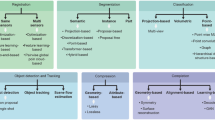Abstract
3D point cloud data, which are produced by various 3D sensors such as LIDAR and stereo cameras, have been widely deployed by industry leaders such as Google, Uber, Tesla, and Mobileye, for mobile robotic applications such as autonomous driving and humanoid robots. Point cloud data, which are composed of reliable depth information, can provide accurate location and shape characteristics for scene understanding, such as object recognition and semantic segmentation. However, deep neural networks (DNNs), which directly consume point cloud data, are particularly computation-intensive because they have to not only perform multiplication-and-accumulation (MAC) operations but also search neighbors from the irregular 3D point cloud data. Such a task goes beyond the capabilities of general-purpose processors in realtime to figure out the solution as the scales of both point cloud data and DNNs increase from application to application. We present the first accelerator architecture that dynamically configures the hardware on-the-fly to match the computation of both neighbor point search and MAC computation for point-based DNNs. To facilitate the process of neighbor point search and reduce the computation costs, a grid-based algorithm is introduced to search neighbor points from a local region of grids. Evaluation results based on the scene recognition and segmentation tasks show that the proposed design harvests 16.4 × higher performance and saves 99.95% of energy than an NVIDIA Tesla K40 GPU baseline in point cloud scene understanding applications.
Similar content being viewed by others
References
Gallardo N, Gamez N, Rad P, et al. Autonomous decision making for a driver-less car. In: Proceedings of IEEE System of Systems Engineering Conference (SoSE), Waikoloa, 2017. 1–6
Lin S C, Zhang Y, Hsu C H, et al. The architectural implications of autonomous driving: constraints and acceleration. In: Proceedings of International Conference on Architectural Support for Programming Languages and Operating Systems, 2018. 751–766
Kuindersma S, Deits R, Fallon M, et al. Optimization-based locomotion planning, estimation, and control design for the atlas humanoid robot. Auton Robot, 2016, 40: 429–455
Wang X J, Zhou Y F, Pan X, et al. A robust 3D point cloud skeleton extraction method (in Chinese). Sci Sin Inform, 2017, 47: 832–845
Qi C R, Su H, Mo K, et al. Pointnet: deep learning on point sets for 3D classification and segmentation. In: Proceedings of the IEEE Conference on Computer Vision and Pattern Recognition (CVPR), 2017. 1: 4
Qi C R, Yi L, Su H, et al. Pointnet++: deep hierarchical feature learning on point sets in a metric space. In: Proceedings of Neural Information Processing Systems, 2017. 5099–5108
Vazou N, Seidel E L, Jhala R, et al. Refinement types for Haskell. SIGPLAN Not, 2014, 49: 269–282
Chen Y H, Emer J, Sze V. Eyeriss: a spatial architecture for energy-efficient dataflow for convolutional neural networks. In: Proceedings of ACM SIGARCH Computer Architecture News, 2016. 367–379
Krizhevsky A, Sutskever I, Hinton G E. Imagenet classification with deep convolutional neural networks. In: Proceedings of Advances in Neural Information Processing Systems, 2012. 1097–1105
He K, Zhang X, Ren S, et al. Deep residual learning for image recognition. In: Proceedings of the IEEE Conference on Computer Vision and Pattern Recognition, 2016. 770–778
Su H, Maji S, Kalogerakis E, et al. Multi-view convolutional neural networks for 3D shape recognition. In: Proceedings of IEEE International Conference on Computer Vision, 2015. 945–953
Soltani A A, Huang H, Wu J, et al. Synthesizing 3D shapes via modeling multi-view depth maps and silhouettes with deep generative networks. In: Proceedings of the IEEE Conference on Computer Vision and Pattern Recognition, 2017. 1511–1519
Qi C R, Su H, Niessner M, et al. Volumetric and multi-view cnns for object classification on 3D data. In: Proceedings of the IEEE Conference on Computer Vision and Pattern Recognition, 2016. 5648–5656
Zhou Y, Tuzel O. Voxelnet: end-to-end learning for point cloud based 3D object detection. In: Proceedings of the IEEE Conference on Computer Vision and Pattern Recognition, 2018. 4490–4499
Hua B S, Tran M K, Yeung S K. Pointwise convolutional neural networks. In: Proceedings of the IEEE Conference on Computer Vision and Pattern Recognition, 2018. 984–993
Song L, Wang Y, Han Y, et al. C-brain: a deep learning accelerator that tames the diversity of CNNs through adaptive data-level parallelization. In: Proceedings of Design Automation Conference (DAC), 2016. 1–6
Wu Z, Song S, Khosla A, et al. 3D shapenets: a deep representation for volumetric shapes. In: Proceedings of the IEEE Conference on Computer Vision and Pattern Recognition, 2015. 1912–1920
Armeni I, Sener O, Zamir A R, et al. 3D semantic parsing of large-scale indoor spaces. In: Proceedings of the IEEE Conference on Computer Vision and Pattern Recognition, 2016. 1534–1543
Muralimanohar N, Balasubramonian R, Jouppi N P. CACTI 6.0: a tool to model large caches. HP Laboratories, 2009, 22–31
Acknowledgements
This work was supported in part by China Scholarship Council (CSC), in part by National Natural Science Foundation of China (Grant Nos. 61804155, 61522406, 61834006, 61532017, 61521092), in part by Beijing Municipal Science & Technology Commission (Grant Nos. Z171100000117019, Z181100008918006), in part by Strategic Priority Research Program of the Chinese Academy of Sciences (Grant No. XDPB12), in part by the Youth Innovation Promotion Association CAS, in part by the Young Elite Scientists Sponsorship Program by CAST (Grant No. 2018QNRC001), and in part by the Innovative Project of ICT, CAS (Grant No. 5120186140).
Author information
Authors and Affiliations
Corresponding authors
Rights and permissions
About this article
Cite this article
Liu, B., Chen, X., Han, Y. et al. Accelerating DNN-based 3D point cloud processing for mobile computing. Sci. China Inf. Sci. 62, 212206 (2019). https://doi.org/10.1007/s11432-019-9932-3
Received:
Accepted:
Published:
DOI: https://doi.org/10.1007/s11432-019-9932-3




